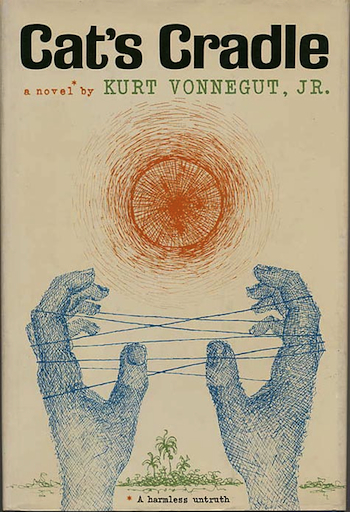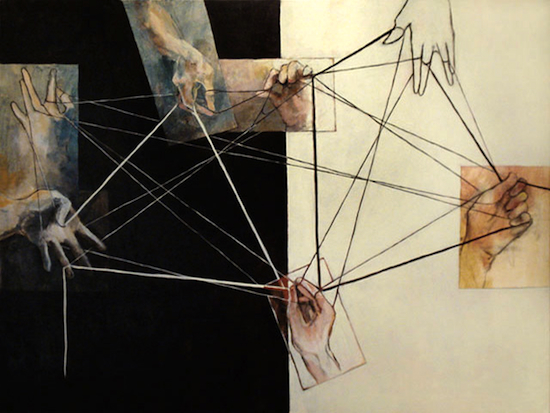When he taught fiction writing at the Iowa Writers’ Workshop in the ‘60s, Kurt Vonnegut would remind his students they were in the entertainment business. Writing might be a merciless process, sure, but what comes out the other end has to be fun. Maybe it’s this – the fun factor – that’s meant his own work has sometimes been considered not as literary or highbrow as that of his contemporaries. Not for him the endless wordplay of Pynchon, the deadpan psychological excavations of DeLillo or the absurdities of Heller. His writing can feel cartoonish, brusque and broad-strokes, and Cat’s Cradle, with its short chapters reading like a succession of comedy sketches, is perhaps the apotheosis of this. Yet, despite its weightlessness, it packs a serious punch.
Vonnegut’s style is inimitable: absurd characters and fantastical situations depicted with such assurance you can’t help but take them seriously. His number one trick is to use flamboyant anti-realism to convey realistic emotions. In his essay collection Fates Worse Than Death, he explains why he does so, aligning himself with the great Donald Barthelme as an ‘aggressively unconventional storyteller’ who tries to build ‘dwellings such as no-one has ever seen before, but which prove to be eminently inhabitable.’ This boldness might make his work reductive in some sense; but it doesn’t matter, because it’s also the reason for its brilliance.
Cat’s Cradle’s dissolute narrator, John, sets out to write a history of the day the atom bomb was dropped on Hiroshima and becomes embroiled in the life of Felix Hoenikker, the fictional father of the bomb, and his three children. In a completely improbable plot, John ends up on San Lorenzo, a made-up Caribbean island, with the Hoenikker siblings and various other unlikely characters. Here, Vonnegut stages an end-of-the-world black comedy – one that both looks at the dark historical moment in which it was written, just after the Cuban Missile Crisis, and also spreads its existential wings far further.
Lots of Vonnegut’s aphorisms are well known, but one with an especially strong resonance is: ‘I tell you, we are here on earth to fart around, and don’t let anybody tell you any different.’ Cat’s Cradle takes up this proposition: its asks us “what is there to live for?’ As for an answer, it’s brimming with pessimism – but is this the whole story? And why would Vonnegut explore this question in a setting that’s little other than a hallucinatory apocalypse? Surely that’s loading the dice.
San Lorenzo is a mishmash of crude clichés if ever there were one – Benjamin Kunkel shows how in his brilliant introduction to the 2008 edition: ‘it boasts a dictator called ‘Papa’ (shades of Haiti’s ‘Papa Doc’ Duvalier?), a tutelary sex goddess (Argentina’s Eva Peron?), a retired Nazi doctor (Mengele in Paraguay?) and a savagely exploitative history of sugar cultivation (several candidates here).’ It’s a ludicrous place, where reality is fashioned entirely to suit the contours of Vonnegut’s imagination. It’s this that allows it to be the perfect stage for a showdown between two “ultimate sources of meaning” – two ways to keep pessimism at bay – religion and science.
The religion of Bokononism rules San Lorenzo, but covertly – no one claims outright to be a Bokononist; it’d get you get hung on the Game of Thrones-like ‘hook’ if you did. Bokonon himself (in my eyes, a cartoonish take on Ghandi) is spectacularly evasive – he’s not been seen for years. And the religion’s key tenet is that it’s a lie. In other words, it’s profound, but empty. It offers wisdom and meaning, but undercuts this by reminding you that this succour is utter bollocks. The fourteenth book of Bokonon asks: What Can a Thoughtful Man Hope for Mankind on Earth, Given the Experience of the Past Million Years? The answer? ‘Nothing.’ If anything should signal the end of illusion and the beginning of existential despair, it’s a religion that relentlessly reveals itself to be a joke. The weird thing, though, is the characters of Cat’s Cradle still draw strength from it. John, too, slowly turns into a Bokononist. They know they’re fools to believe it, yet they still do.
The only bit of Bokononist philosophy that’s not shrouded in self-refuting riddles is the outlandish, but great, concept of boko-maru (pressing the bare soles of your feet against someone else’s). The importance of this practice as a way of expressing love suggests a shade of hope beyond the meaningless farting around. It means that Bokononism is part of Vonnegut’s deep, mocking pessimism ¬– but simultaneously contains a sliver of hope and redemption. How does that square with the fact that Vonnegut was a staunch humanist, and honorary president of the American Humanist Association? I don’t know. Maybe he just thought that while religion might be based on illusion, you can’t deny that it offers its consolations.

Science, on the other hand, is as flesh-and-blood real as you can get – yet what do we do with it? According to Vonnegut: destruction. (Bear in mind the 1963 context – the world had just narrowly avoided nuclear disaster.) In Cat’s Cradle, the atomic bomb has a mutant twin: ice-nine, a substance that can freeze all life on earth. Hoenikker invents it while working on the bomb, and it’s clear that he develops them both for a sole purpose – the pursuit of knowledge. Vonnegut’s not condemning the truths that science leads to, though. He’s just showing, with ice-nine, that we can pursue science in order to understand the universe, but that we seem hard-pressed to use this power of understanding for good.
This deep pessimism about our pursuit of science continues with the fact that Hoenikker’s kids – who each inherit a Mason jar of ice-nine – choose to use it. The only likeable one of the trio, Newt, is one of the novel’s few genuinely warm characters. And yet when it comes to ice-nine, ‘there was no talk of morals.’ Is this Vonnegut suggesting that Newt has inherited flickers of his father’s cold amorality? Or maybe it’s the fact that we can’t get science and morality to square up. Our imaginations fall into the gap in between – the God-like powers of science dazzle so much that we’re blind to its moral implications. Having nice guy Newt be a part of this, too, might be Vonnegut’s way of saying that the awesome powers of science – like those of religion – make idiots of us all.
Cat’s Cradle’s take on religion and science, then, is that we stumble around searching for meaning, grasp like fools at the totalising narratives they offer, and remain determinedly oblivious to the compromises they require. Isn’t this sad? Maybe instead, we should just be farting around – and occasionally putting the soles of our feet together.

Cat’s Cradle remains in print, published by Penguin. Painting by Baila Goldenthal


